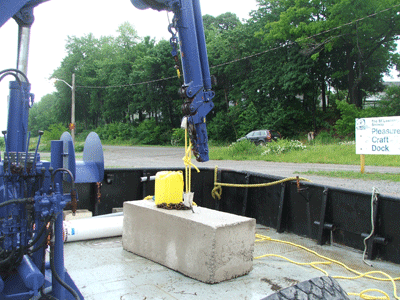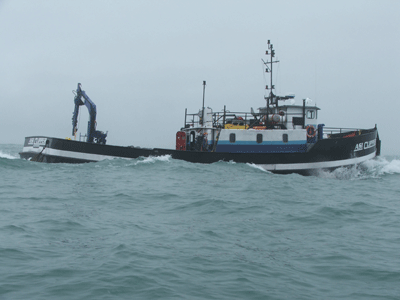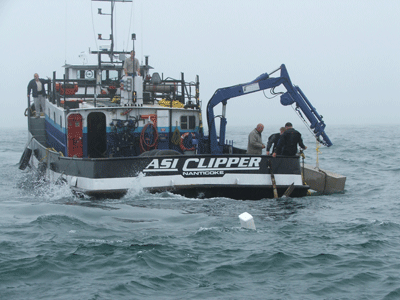New Tiller Mooring
In July/2002 the NDA placed three
small mooring blocks
(chained together) on the Port Dalhousie Tiller wreck. At
some point last spring or late the previous
fall, the rebar pulled out of the concrete on one, leaving only two
blocks. One of the remaining two also had
one side of
the rebar pull out, but we managed to hammer it into a loop and clamp
it in place. The weight is not suitable for anything more than
small vessels.
|
This spring we were asked to
remove our new buoy
and sink
our line, as the Coast Guard had to set a heavy mooring (8000# block
and large buoy) for a survey
vessel to
use. This vessel was far too large for
the mooring we had in place.
We had hoped that the Coast Guard would leave the
mooring
block for us (we even offered to supply them with one) but we were told
that it
had to be removed, as they could not accept liability by having a
private
mooring attached to it. The day after the Coast Guard removed their
block, with the help of John Schertzer and Pearl Dive Charters we
raised our line and reattached the buoy.
The ASI Clipper
was the vessel used for the survey
and when
ASI Group heard that we needed a new mooring block, they offered to
take one
out for us. Jean-François Pelletier
welded some 5/8” chain and steel rod for us, which I dropped off at
Dufferin
Concrete in Niagara Falls. The next day, Spencer Shoniker supplied his
truck
and trailer and we delivered the new 2700 pound block to the Clipper’s
mooring.
|
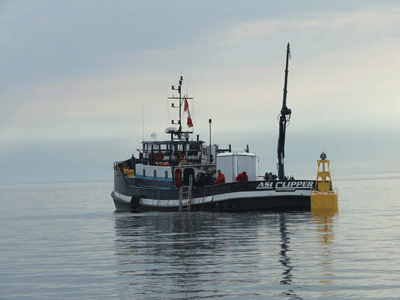
Survey mooring in place (May
2009) Photo © Barb Marshall
|
Last Thursday (July 18/09) Spencer
took Jack
Wenger, my wife
Barb and me out on his boat to get everything ready on the wreck.
We took
our time as we had 4.5 to 5 foot waves most of the day. We had placed a
jug on
the bow a couple of weeks before and we needed to make sure that it was
still
there and the line had not stretched out.
We also put another marker in a clear area off the bow to mark
the area
we wanted to drop the block. We also removed our mooring buoy from the
original
line and replaced it with a foam filled jug.
Jack did all the diving on our morning trip. Next, we headed
into
Port
Weller to meet up with the ASI Clipper and crew.
|
Block
Loaded onto the ASI Clipper
Photo © Barb
Marshall
|
Even
a 70 footer bounces in 5'
waves
Photo © Barb
Marshall
|
ASI
members Darren at wheelhouse, Richard at aft helm,
Rob controling the hiab. NDA
members Ian & Jack in dry suits
Photo © Barb
Marshall
|
Darren, Rob and Richard from ASI
group met us on
board; they
had just used their 3 ton hiab to lift the block on board. We rigged it
up
completely on board with chain, jug, line and buoy and discussed how we
were
going to drop it into position before we headed out. Jack and I were
aboard the
Clipper to manhandle the block while Rob worked the hiab. Spencer and
Barb
followed us out keeping the boat in the Clipper’s wake to make for a
smoother
ride. After a dry run, Rob hoisted the
block over the side and Richard, using the stern controls, backed the
block up to
our mark. One quick slice of a razor knife and the block was set. As it was still too rough for Spencer to come
alongside, Jack and I left the clipper and swam over to Spencer’s boat.
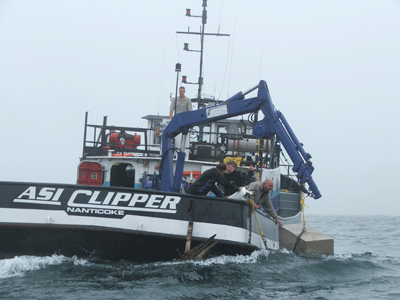
Photo © Barb Marshall
|
A few final directions , one
cut of the knife and it was gone. |
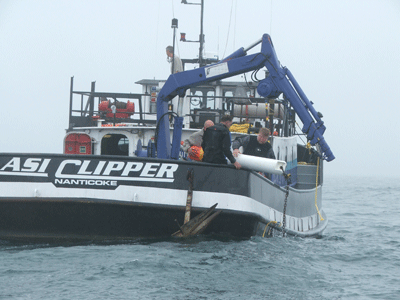
Photo © Barb Marshall
|
After tying off to the buoy, I went
down to
install the tag
line to the wreck and that’s when I found out that we had a problem.
The block’s
position from the wreck was perfect, but the block had flipped on the
way down
and the chain was on the bottom with the poly line chaffing against the
block.
It was totally unusable this way. When I surfaced and explained the
problem,
Barb quickly phoned Darren on the Clipper but they had already tied up
and the
captain had left for an appointment. I had hoped to use their hiab to
pull up on the line just enough to flip the block. We had three small
lift bags and
jugs on
the boat, but even with the help of the engines we were unable to pull
the
chain out or flip the block. We were SOL for the day. Having no other
choice, I
cut the line as close to the block as I could and we once again moved
the buoy
back to the original line.
We planned to go out
last Saturday but the thunder
storms
kept us off the lake. Today (Friday, June 26/09) was the first chance
we had to
get back out. The thunder storms cleared
out this morning and we headed out just after noon. First job was for
Jack and me
to pull down the line attached to our 4000 # lift bag and tie it off to
the
chain. We had it rigged so that the bag would be at about 10’ of depth.
Jack
inflated the bag and I cut it loose as soon as the chain was clear. I
surfaced,
and then took down the new line, bottom jug and tag line and hooked
everything
up. After Barb and Spencer deflated the
lift bag, Jack took it down and attached it to the old mooring blocks
and
untied the original tag line from those blocks. By the time I finished
my 23
minutes of deco, the others had everything ready to go.
My plan was to mark a
new location, float the
blocks and then
use the boat to pull them into place. Spencer thought that with the
little
wind and
current we had that day, he could just swim the blocks into position
and did a quick
bounce to
check things out while Jack attached a fresh tank to the lift bag. On
the first
try, the bag was set too shallow and the blocks didn’t quite clear the
bottom .
After deflating the bag and shortening
the line we tried again. This time the blocks rose about 6’ off the
bottom. Jack headed down to help Spencer
swim the
blocks into position, but Spencer had beaten him to it and cut the line
to
drop the
blocks before Jack got to the bottom.
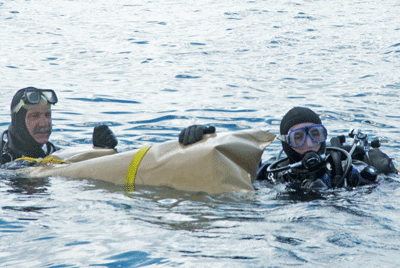
Photo © Barb Marshall
|
Spencer (left) and Jack (right)
deflating the bag after the first
attempt to raise the old blocks.
Blocks
being swam into position under inflated 4000# bag
|
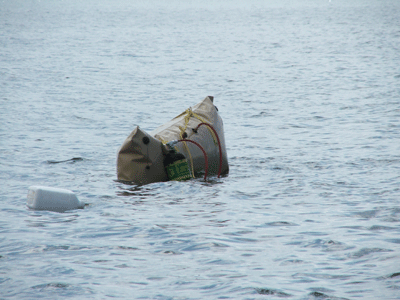
Photo © Barb Marshall
|
Barb was to do the last dive and
attach a new tag
line to
the wreck but we had run out of time.
Spencer
had an appointment in Welland that he couldn’t miss, so we moved the
buoy (for
about the fifth time) to the new mooring, put a foam filled jug on the
relocated original and headed back to shore. James Detenbeck made a run
out to the site and installed the final bottom tag line from the block
to the wreck on Friday July 3/09.
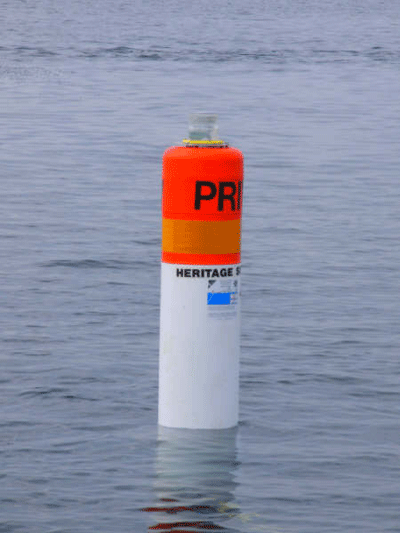
Photo © Jim Lockard
|
New buoy in position
Buoy
in use
|
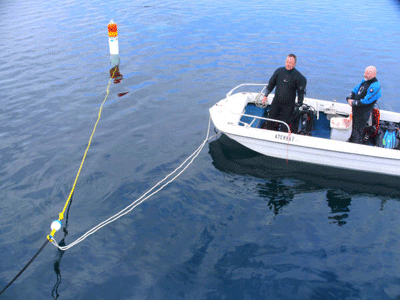
Photo © Jim Lockard
|
The new mooring has the buoy and the block is 22’
off the
port bow. The original mooring was port amidships and is now about 30’
further
aft closer to the stern. The buoy is the preferred mooring, the jug
should be used by smaller boats only.
Return to NDA Mooring Page
Return to Mooring Articles

